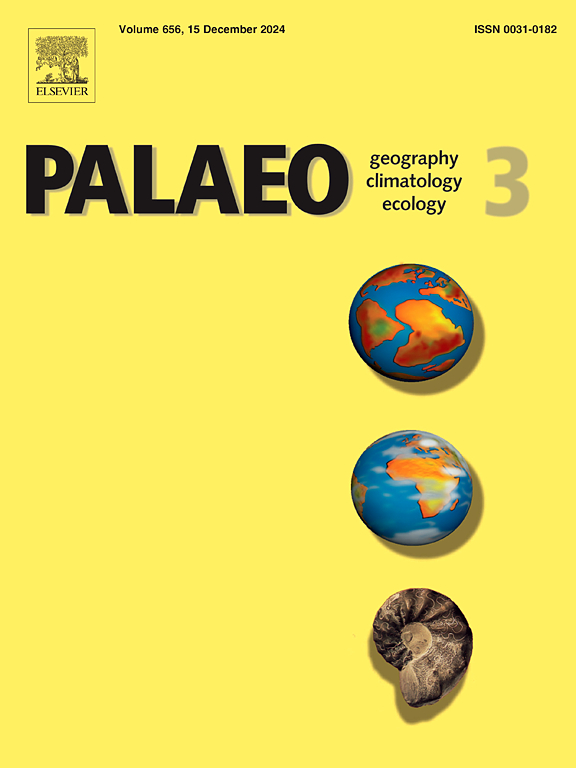海拉尔盆地早白垩世兴安岭群古生态与古气候:新的孢粉学和辐射资料
IF 2.7
2区 地球科学
Q2 GEOGRAPHY, PHYSICAL
Palaeogeography, Palaeoclimatology, Palaeoecology
Pub Date : 2025-07-21
DOI:10.1016/j.palaeo.2025.113156
引用次数: 0
摘要
早白垩世标志着陆生植物区系演化和分布的一个动态区间,与重大的气候和构造重组相一致。在中国,这一时期广泛分布的大陆沉积物产生了丰富的孢粉植物,为了解欧亚大陆东部的植被动态和古气候模式提供了见解。在这些盆地中,中国东北海拉尔盆地以其广泛而连续的超过6000 m的沉积序列而闻名,该盆地保存了详细的陆地环境记录。HD4井在盆地红旗凹陷内钻探,捕获了迄今为止记录最完整的早白垩世序列。该剖面由粗粒冲积、河流沉积向细粒湖相沉积过渡,属于兴安岭组(铜庙组和南屯组)。本研究利用HD4井的新孢粉资料,并辅以邻近火山层的锆石U-Pb年龄,对贝里亚—巴雷米亚早期三个孢粉组合进行了划分。这些生物地层推断与来自两个地层的新的LA-ICP-MS锆石U-Pb日期吻合良好。植物组成的变化反映了从以苏铁植物为主的大温植物群落向以蕨类和苔藓植物为主的温带针叶树丰富群落的转变。这种转变可能标志着环境的稳定和轻微的降温趋势。尽管如此,整个剖面的植被仍然适应湿润条件,这与从铜庙组到南屯组过渡期间湖泊系统的扩张和盆地的逐渐沉降相一致。本文章由计算机程序翻译,如有差异,请以英文原文为准。
Paleoecology and paleoclimate across the Early Cretaceous Xing'anling Group: New palynological and radiometric data from the Hailar Basin (NE China)
The Early Cretaceous marked a dynamic interval in the evolution and distribution of terrestrial floras, coinciding with significant climatic and tectonic reorganization. In China, widespread continental deposits from this period have yielded rich palynofloras that offer insights into vegetation dynamics and paleoclimate patterns across eastern Eurasia. Among these basins, the Hailar Basin in northeastern China is notable for its extensive, continuous sedimentary succession exceeding 6000 m, which preserves a detailed record of terrestrial environments. Well HD4, drilled within the Hongqi Sag of the basin, captures the most complete Early Cretaceous succession documented to date. This section comprises a transition from coarse-grained alluvial and fluvial to fine-grained lacustrine deposits, assigned to the Xing'anling Group (Tongbomiao and Nantun formations). This study presents new palynological data from Well HD4, supplemented by zircon U–Pb ages from adjacent volcanic layers, allowing the differentiation of three palynological assemblages spanning the Berriasian to early Barremian. These biostratigraphic inferences align well with new LA–ICP–MS zircon U–Pb dates from both formations. Changes in floral composition reflect a shift from megathermal, Cycadopites–dominated assemblages to more temperate, conifer-rich communities with increasing proportions of ferns and bryophytes. This transition likely signals environmental stabilization and a slight cooling trend. Despite this turnover, the vegetation throughout the section remained adapted to humid conditions, in line with the expansion of lacustrine systems and progressive basin subsidence during the transition from the Tongbomiao to the Nantun formations.
求助全文
通过发布文献求助,成功后即可免费获取论文全文。
去求助
来源期刊
CiteScore
5.90
自引率
10.00%
发文量
398
审稿时长
3.8 months
期刊介绍:
Palaeogeography, Palaeoclimatology, Palaeoecology is an international medium for the publication of high quality and multidisciplinary, original studies and comprehensive reviews in the field of palaeo-environmental geology. The journal aims at bringing together data with global implications from research in the many different disciplines involved in palaeo-environmental investigations.
By cutting across the boundaries of established sciences, it provides an interdisciplinary forum where issues of general interest can be discussed.

 求助内容:
求助内容: 应助结果提醒方式:
应助结果提醒方式:


